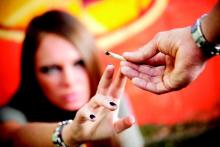AVENTURA, FLA. – Common risk factors, such as genetic risk or family dysfunction, might partly explain the association between higher rates of mood disorders and the use of marijuana among adolescents, Dr. Christopher Hammond said at the annual meeting of the American Academy of Addiction Psychiatry.
Evidence from different types of studies and populations of patients indicate that the rates of adolescents and adults who have an affective disorder and a cannabis-use related disorder or use cannabis “exceed the levels we would expect to see by chance alone,” noted Dr. Hammond of the Yale Child Study Center, Yale University, New Haven, Conn. In addition, over the past few decades, particularly in the last 5 years, cannabis use has increased, especially among adolescents, and to “a lesser extent,” there has also been an increase in depression and suicide rates among young people.
For affective disorders in general, the “evidence is less consistent and less convincing for a causal role” of cannabis than for psychotic symptoms and disorders, Dr. Hammond said. Adolescents and young adults who use cannabis might report that it reduces their anxiety or depression, however, “in controlled experimental studies, the findings are less conclusive,” he noted.
A systematic review of 35 studies from the 1970s through 2006 found that almost all reported an increase in affective outcomes among people who abused cannabis (Lancet 2007;370:319-28). But wide variations exist in the confidence intervals and small effect sizes, and most of the studies were underpowered to examine outcomes, Dr. Hammond said. Studies evaluating whether cannabis use is associated with an increased rate of affective disorders have used a variety of approaches with different study designs and varying levels of use (daily, weekly, monthly, yearly, or “ever”), so a metaanalysis is not possible, he pointed out.
Despite some inconsistent findings in the literature, most prospective longitudinal studies have found that regular early-onset cannabis use is associated with a “modest” increased risk of later depression, Dr. Hammond said. In a pooled analysis of the studies in the systematic review looking at depression, those who used cannabis the most frequently were at about a 1.5 times greater risk of depression than nonusers, and studies published since 2006 have further supported that association.
Cohort studies have made it possible to evaluate whether depression in adolescence and childhood predicts later cannabis use – the reverse causation hypothesis – and, “with few exceptions, [these] studies have failed to find a significant association between child and adolescent depression, and later-onset cannabis use,” he said. Negative studies have included a broad range of samples and are representative of the general population, including a longitudinal study of children in the United States with prepubertal depression.
The systematic review included eight studies that looked at anxiety outcomes, of which three – including two in adolescents – found an association with anxiety disorders and adolescent cannabis use, after controlling for confounding variables. In multiple studies, “the most common finding is that trauma and traumatic distress ... is really the only affective symptom that has been consistently found to predate adolescent cannabis use and to increase the risk of chronic cannabis use across a number of different studies,” he said. In addition, case series and anecdotal reports suggest that acute and chronic cannabis use, and cannabis withdrawal during attempts to stop use, might increase anxiety panic attacks and anxiety disorders in “vulnerable teens.”
Bipolar disorder has the highest rate of substance abuse comorbidity of any neuropsychiatric disorder, and cannabis is considered the “drug of choice” in people with bipolar disorder, but there is a paucity of research systematically examining this association, particularly in adolescents, Dr. Hammond said. The available data indicate that cannabis use appears to elevate the risk of developing mania in people diagnosed with or who are at risk of bipolar disorder, he said.
In studies that have evaluated risk in people with bipolar disorder with and without cannabis use disorder, those who use cannabis have an earlier age of onset of bipolar disorder and earlier age at first hospitalization for bipolar disorder; in one study, adolescents with bipolar disorder and cannabis use disorder had more abnormalities in the prefrontal lobes and temporal and subcortical structures, than those with bipolar disorder only (J. Child Adolesc. Psychopharmacol. 200818:557-63).
A “growing body of evidence” supports an association between adolescent-onset cannabis use and “both concurrent and later risk for suicidal behaviors,” even when controlling for confounding factors, according to Dr. Hammond. The data include a recently published study evaluating the association between levels of cannabis use before age 17 years and suicide and other outcomes up to age 30 in three cohorts of over 3,500 people, which found that those who used cannabis daily before age 17 were about seven times more likely to attempt suicide in young adulthood than those who did not use cannabis (Lancet Psychiatry 2014;4:286-93).


